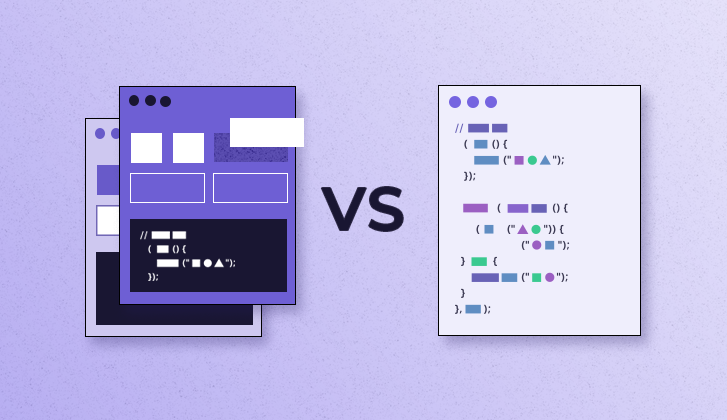No Code, Low Code, or Custom? Founders Insights
Low-code and no-code tools have gained significant traction in recent years, promising the quick development of a software product from scratch with little to no code.
The demand for rapid product development, the tech skill shortage and the increasing challenge of attracting and retaining skilled developers are among the drivers of the ‘no-code movement’.
Low-code and no-code tools promise to address these needs by providing intuitive, user-friendly environments to design, develop, test and deploy software applications. And they have certainly made technology more accessible and empowered ‘citizen developers’.
But while the ability to build an app without writing a single line of code is compelling, founders and entrepreneurs should carefully evaluate the pros and cons.
So in this article, we’re answering the question: How do low-code and no-code platforms compare to traditional development?
Read on for a full breakdown of the benefits and limitations of low code and no code to help you choose the best approach for your project.
What is no code?
No code refers to a software development approach for building software products without writing a single line of code. No-code platforms like Bubble and Glide provide a visual, drag-and-drop interface where users can create apps using pre-built components and templates.
A report by Zapier found that the no-code movement started around the pandemic - the beginning of 2020 to the beginning of 2022, when the majority of respondents said they first started using no-code tools.
Since then, such platforms have seen significant growth and adoption across various industries. Gartner predicts that by 2025 70% of new apps developed by organisations will use no-code or low-code tools.
According to the same study by Zapier, the biggest motivation for adopting and sticking with no-code tools is the significant time savings they offer. These tools can help users streamline tasks and roll out new products and features faster.
The ability and desire to automate certain aspects of your business and the flexibility to build on your terms are other compelling drivers of the no-code movement.
What is low code?
Low code has risen to popularity in parallel with no code, and while many people seem to use the two together, it’s important to note that they are two different things.
While no code refers to building apps without any code at all and is targeted towards non-developers, low code requires actual coding, though minimal.
While low-code platforms also provide ready-to-use building blocks and components, you may still need to write some custom code for more complex functionality. You could say that low code is a middle ground between no code and traditional development.
Low code is aimed at developers with some coding experience who want to speed up the development process by reducing the amount of hands-on coding required.
Popular no-code / low-code platforms
Since no-code and low-code development have risen in popularity, a variety of no-code and low-code tools have emerged on the market. Here are some of the most popular today:
Bubble - Full-stack no-code platform
Bubble is a comprehensive no-code platform that allows users to build full-fledged web applications - SaaS, online marketplaces, social media apps, etc. It includes a visual interface where users can drag and drop elements to create their app, complete with database and back-end functionality.
Softr - No-code platform for simple web apps
Softr is a no-code tool for creating custom web apps, client portals, or internal tools. Softr doesn’t have a native database, so you need to add an external data source from Airtable, Google Sheets, or SQL. Softr doesn’t support native apps yet, only PWAs.
Glide - No-code platform for work software
Glide is a no-code tool marketed for building business apps and internal tools (portals, dashboards, directories, CRM, etc.) from spreadsheets. It was designed to be powered by Google Sheets, but it now supports more integration options.
Adalo - No-code mobile and web app builder
Adalo is a no-code platform designed for creating mobile and web applications. You can build external tools, and native apps that you can deploy to app stores. It also offers built-in functionalities for user authentication, databases, and external API integration.
FlutterFlow - Low-code platform for native apps
Built on Google’s Flutter framework, FlutterFlow allows users to design, build, and deploy native apps on iOS, Android, the web and desktop. Besides a drag-and-drop interface, the platform also integrates with Firebase where you can write custom functions. It’s better suited for MVPs, prototypes or simple apps.
Appian - Low-code platform for business process automation
Appian is a low-code automation platform geared towards enterprise applications. It’s suited for businesses looking to automate their processes, streamline complex workflows and integrate various systems.
Zapier - No-code automation platform
Zapier is a no-code automation tool that connects different apps and services to automate workflows. Users can set up ‘zaps’ to trigger actions between apps, such as sending an email when a new lead is added to a CRM.
Airtable - Low-code tool for creating relational databases
Airtable is a low-code platform that combines the simplicity of a spreadsheet with the power of a database. It allows users to create custom applications by organizing and managing data visually.
Webflow - No-code website builder
Webflow provides an environment for creating responsive websites with drag-and-drop features, CMS and hosting options.
No code / low code advantages

Now let’s look at the key advantages promised by no-code and low-code tools, and hear from entrepreneurs who have experienced these benefits first-hand:
Quick time-to-market & rapid development
One of the most compelling reasons founders turn to no-code and low-code solutions is reducing the time it takes to build and deploy an app.
Benoit Lecureur, Founder of Saasreach AI - a comprehensive sales outreach tool powered by AI, shared that speed was the biggest factor in his decision:
“The biggest factor was speed. No-code tools like Bubble enable rapid prototyping and deployment without the need for extensive coding knowledge. The major advantages included reduced development time, cost savings, and the ability to easily make changes based on user feedback.”
Some no-code tools promise to deliver a functional app in a few clicks. While this is a marketing exaggeration, using a no-code tool to build an app should indeed take less time compared to custom development. Such tools have readily available templates and components that you can use for your app and save the time it would take to build from scratch.
However, this also means that you’ll have to limit the look and feel of your product to what’s readily available on the platform. If you’re building something totally novice or niche, you might need some advanced customisation that might take longer to do in a no-code environment.
Reduced initial costs
Developing software from scratch often requires hiring a team of skilled developers, which can be expensive. No-code and low-code platforms can help reduce these initial costs by lowering the barriers to entry. Even those without technical expertise can create functional apps, particularly with no-code platforms, significantly cutting labour costs.
Many no-code and low-code platforms also offer flexible pricing models, such as subscription-based plans. This is a compelling option especially for startups and small businesses as it provides a predictable, manageable expense.
Hélène Lucien, Chief Product Officer and Entrepreneur, shared that this cost efficiency was one of the main reasons she chose a no-code platform for Makezu - a social media marketing automation platform:
“The final implementation cost for the project was significantly lower than what it would have been with custom development. Bubble allowed us to develop and launch our MVE with a fraction of the budget that would have been required for a traditional development approach.”
She also explained that this way her team could allocate more resources towards other critical areas:
“We decided to invest in AI algorithms based on NLP and machine learning. To save money, Bubble was great because we could afford to hire high-profile mathematics and machine learning talent.”
Great for MVP development and prototyping
For startups and companies looking to test new ideas, no-code and low-code platforms are very well suited for building Minimum Viable Products (MVPs) and prototypes. They provide speed and cost-effectiveness - two important factors for MVP development.
Ben Waterman, Founder of Strabo - a customisable portfolio tracking platform, shared:
“As two non-technical co-founders, we needed to build an MVP quickly in order to prove our concept to investors.
We did consider other options, including hiring a CTO and paying for a development agency, but these were a large commitment for a product that wasn’t yet proven. We wanted a quick messy tool to know if people wanted our solution before investing large amounts of time and money.
We could throw together an MVP using Bubble in a matter of weeks that would have taken months if fully coded.”
Empowering non-devs
No-code tools are designed to be as user-friendly as possible, so anyone regardless of technical knowledge can dive into software development. For example, customer service teams can now build internal dashboards to track and address support tickets without developers. This can significantly enhance operational efficiency, empowering businesses to respond more swiftly and effectively to customer needs.
No code / low code limitations
If you’re a non-technical user, the primary target audience for no-code tools, you might find it challenging to fully grasp the technical limitations of a no-code app. In this section, we’ll go over the most common challenges that founders face when developing their product in a no-code or low-code environment:
Difficult to scale
One of the primary limitations of no-code and low-code platforms is scalability. While they are great for building MVPs and small-scale applications, they may struggle to handle larger, more complex projects.
Ben Waterman explained that they used Bubble to build the MVP for Strabo to validate their idea and attract investors, but later transitioned to a coded stack for the final product:
“The main reason that Bubble wasn’t appropriate for the final product was that we had too much data and Bubble didn’t have the infrastructure to handle it. We also wanted complete flexibility on feature design and didn’t want to run the risk of making big progress on a platform that had any limitations. Back then there were very few fintechs on Bubble for this data reason, so it made sense.”
As your user base grows and your application requires more advanced features, you might find that the platform's capabilities are insufficient, leading to performance bottlenecks and the need for significant reworking or migration to a more robust solution.
Benoit Lecureur shared: “As for scaling, Bubble handles it well up to a point, but for very high traffic, performance optimization and potentially transitioning to custom development might be necessary.”
Limited customization options
No-code and low-code platforms may work great when you’re working with their pre-built components and templates. However, the moment you want to customize certain elements, you may find the process not as easy or intuitive.
It’s also worth pointing out that there’s a difference from platform to platform. Some no-code and low-code platforms offer more flexibility and customization options than others, so you’ll have to carefully evaluate their capabilities against what you want to build.
Hélène Lucien shared: “There were instances where we needed specific functionalities that weren't readily available on Bubble. We had to find workarounds or integrate third-party services to achieve our goals.”
You should keep in mind that advanced customizations might be difficult or impossible to implement. This limitation can be frustrating if your app has unique requirements that the tool cannot accommodate.
Fabian Mürmann, Head of Product and Tech at Raus, explained that they opted to build only certain parts of Raus with no code, rather than the whole product for this reason:
“Our website and embedded cabin booking engine is a custom-built application as our requirements would definitely not be possible to be covered with no/low code and even considering taking that route would have been a costly dead end.
However, we use Retool to build tools for our internal teams and external partners (Cleaners, Food-Delivery-Mainteance, Landowners). We chose that as it's pretty easy to build a solid user interface in Retool while connecting all sorts of services to it. As all our services have APIs it's a pretty straightforward thing to do.
In the end, it's a matter of prioritization and being able to build something that's "good enough for now" following the 80/20 Rule with limited resources. Plus, it allows us to learn early which aspects are driving the most value. We might also re-built all these with custom development at some point and if we do: We know exactly what we must build.”
Responsive design issues
Responsive design is a critical component in modern software development. Making sure your app functions seamlessly across different devices and screen sizes is essential for providing a consistent and positive user experience.
With no-code and low-code tools, we’ve found many users who report issues with responsive design. Hélène Lucien shared her experience with Bubble:
“We did encounter challenges with responsive design on Bubble. Making certain elements fit properly across different screen sizes required a lot of tweaking and testing. To address this, we focused on displaying only key indicators on mobile devices, intentionally limiting the accessible features to enhance the user experience.”
No-code tools like Bubble typically offer a set of pre-designed templates and components that are optimised for common use cases. While this can speed up development, it can also restrict your ability to create a fully responsive design tailored to your specific needs. This means that sometimes you might need to make trade-offs.
This can be the case with other no-code tools as well, such as Retool. Fabian Mürmann shared:
“Retool can be slow when running an "app" in the browser, especially on slightly older smartphones.
Their "Retool Mobile" product has not been usable for us as the components are somewhat different and their navigation patterns do not work for us. So we're using mobile-adjusted screens of their "apps", which is OK, again 80/20, but far from what we'd be able to achieve with custom-built.”
Performance limitations
One of the trade-offs of using no-code and low-code platforms is the lack of granular control over performance optimization. With custom development, developers can fine-tune every aspect of the app's performance, from optimizing database queries to minimizing server response times.
With no-code and low-code tools, you’re limited to the optimization options provided by the platform, which might not be sufficient as the complexity of your product increases.
Hélène Lucien shared: “We did notice some issues as our user base grew, particularly with load times and database queries. This required optimizing our workflows and, in some cases, considering external database solutions.”
Steep learning curve
No-code tools are designed to require no coding or technical expertise, at least in theory. While it’s true that these platforms allow you to build apps without writing any code, having some technical expertise can significantly enhance your experience and the quality of your product.
Some level of understanding of development concepts - such as databases, user interface design, and logic flow - can help you navigate the platform more effectively and make the most of its capabilities.
Fabian Mürmann shared his point of view:
“As someone who built his very first application in Visual Basic 6.0... somewhere in 1998 I personally found Retool insanely easy to use. But it's a false assumption that "one can just build an app in Retool as someone with no technical understanding". I mean, one can do that, but the ceiling is pretty low in such a case.
I actually do not see Retool as a no-code tool, but more as an online application builder. And to build, you still need engineers to build well. So, I do not think it's much about the learning curve but more about the expectation and capability to build in whichever environment.”
Benoit Lecureur admitted that getting used to Bubble required some time and patience:
“Bubble does have a learning curve, especially if you aim to build complex functionalities. It’s user-friendly for basic tasks, but for more advanced features, a good understanding of web development principles is beneficial. Initially, I spent a significant amount of time learning and experimenting, but it paid off as I became more proficient.”
It's also common for founders who began building their product on a no-code platform to hire a freelance developer or an agency specializing in that platform to help implement more advanced features.
This was the case for Ben Waterman who explained:
“We found Bubble quite easy to pick up, although for the back end/database parts of the platform we engaged with some external help. There are a lot of no-code agencies who offer this for very little money, so this is pretty easy to get help on. This sounds counter-intuitive, but it still works out much cheaper and faster than a full code stack.”
Costs can add up
Although no-code and low-code platforms often have lower initial costs compared to custom development, ongoing subscription fees can accumulate over time. As your application scales and requires more advanced features or higher usage limits, the costs can increase significantly.
What’s more, users often need to integrate third-party services or use multiple no-code and low-code tools to create a fully functional product that meets their needs, all with a separate price tag that can quickly inflate your budget.
Vendor lock-in
One important factor that you need to consider when it comes to no-code and low-code platforms is the risk of vendor lock-in. Vendor lock-in can negatively impact your business's flexibility and long-term strategy.
Vendor lock-in occurs when a business becomes overly dependent on a particular vendor's platform, making it difficult to switch to another provider or migrate to a custom solution without significant effort and expenses.
For example, Bubble is a ‘lock-in’ platform that uses proprietary technology and infrastructure, which can complicate the process of migrating your app and data to another platform. It’s not impossible, but it can be a hassle with a hefty price tag, potentially disrupting your operations.
No code / low code vs traditional development

Now that we've covered the advantages and limitations of no-code and low-code tools, let’s see how they compare to custom development solutions:
Custom development pros & cons
✅ Complete control over the process
Custom development offers complete control over the development process. From initial design to final deployment, every aspect of the application can be tailored to meet your specific requirements.
✅ Ownership of the source code
With custom development, you own the source code. This means you can modify, extend, and optimise the code without restrictions. Having the source code at your disposal ensures long-term flexibility and reduces dependency on external vendors or platforms.
It also allows for easier troubleshooting and debugging, as developers can access and change any part of the codebase.
✅ Easier integrations with other systems
Integrating with other systems and services is often more straightforward with custom development. Developers can build custom APIs and connectors to ensure seamless data flow and interoperability between different software systems.
👎 More resource extensive
One of the main drawbacks of traditional development is that it requires significant investment in terms of time, effort, and resources. You need a skilled team of designers and developers to build a product from scratch. This can be a barrier for startups and small businesses with limited budgets.
No Code / Low Code vs Full Code: Comparison Table
| No Code / Low Code | Full Code | |
|---|---|---|
| Scalability | Suitable for small to medium-scale applications. May face limitations as complexity grows. | Highly scalable, can handle large, complex applications with custom optimizations. |
| Flexibility | Limited by the platform’s capabilities and predefined components. | Fully flexible, you can build a product tailored to your unique requirements. |
| Functionality | Great for basic to moderately complex applications. Advanced features may require workarounds. | Capable of implementing highly complex and unique features. |
| Cost | Lower initial costs with subscription-based pricing. Costs can add up over time. | Higher upfront costs, long-term costs depend on maintenance and development needs. |
Use cases
No Code / Low Code
- Prototypes and MVPs: Ideal for quickly developing prototypes and Minimum Viable Products (MVPs) to test ideas and gather feedback without a large investment.
- Specific use cases: Perfect for applications that fit within the platform’s capabilities and require minimal customization. For example, business process automation, internal tools, or client portals.
- Rapid development: Suitable for projects with tight timelines where speed is crucial, and the initial functionality can be achieved using pre-built components and templates.
Traditional Development
- Complex, large-scale applications: Best for applications that require extensive customization, complex features, and need to scale efficiently.
- Unique business requirements: When the application needs to meet very specific business processes and workflows that cannot be easily replicated with no-code or low-code platforms.
- Long-term projects: Ideal for projects where long-term flexibility, performance, and control are critical. Custom development ensures the app can evolve and adapt without platform constraints.
How to choose the right approach? Things to consider

If you’re still debating whether to go ‘no code’, 'low code' or ‘full code’, consider the following factors before making a decision:
Business requirements
Start by clearly defining your business requirements. What specific features and functionalities does your product need? Who are your target users? Understanding your core requirements will help you determine whether a no-code/low-code platform can meet your needs or if you need custom development.
Benoit Lecureur’s word of advice for fellow entrepreneurs: “My advice would be to thoroughly evaluate your project’s requirements and match them against the capabilities of no-code tools.”
If your project involves creating a simple tool to automate business processes or a prototype to test a new idea, a no-code or low-code platform might be a good fit. These platforms are designed for rapid development and can get your app up and running quickly.
However, if your product needs to integrate with multiple systems, handle complex workflows, or provide unique functionalities tailored to your business, traditional development may be more suitable. Custom development allows you to build solutions that align perfectly with your business needs, without the limitations of pre-built components.
Hélène Lucien raised a point about carefully evaluating not only the advantages but also the limitations of no-code tools:
“My advice to other entrepreneurs would be to thoroughly assess the scope and requirements of your project. No-code platforms like Bubble are great for rapid prototyping and MVPs / MVEs, but they do have limitations in terms of customisation and scalability.”
To evaluate if no code is right for your project, Fabian from Raus shared a step-by-step process that helped him figure things out with Retool:
“1. Jump right in and try a few things. Give it a specific, isolated task/feature/problem that you experiment with. See if you get value fast.
2. Afterwards take the time to evaluate if the learnings contribute to the larger, strategic side of things. Also, consider vendor lock-in effects, service location (data, gdpr) etc.
3. If it's still a thumbs up, do de-risking by simulating: It might be that, down the road, one reaches a roadblock about something that can't be done with i.e. Retool. Take some time and "wireframe" the majority or key aspects right in Retool. That way you see where you'd need custom components or have a role/permission thing to figure out.
4. Once that's done you can start wiring it up. And that depends on the business as here it comes down to: Is the needed data available in a connectable way?”
Budget & timeline
Your budget and timeline will play a key role in deciding which development approach is right for your project. No-code and low-code tools typically have lower initial costs and can significantly reduce development time, which is beneficial if you need to launch quickly or have limited resources.
However, while these platforms can be cost-effective in the short term, it’s important to consider ongoing subscription fees which may accumulate over time and potential cost increases associated with scaling and customization. Traditional development may require a higher upfront investment, but it also offers greater control over long-term costs and avoids potential vendor lock-in.
Technical expertise
Despite their user-friendly design, no-code and low-code platforms have a learning curve. You need to be prepared to spend some time getting familiar with the platform's interface, available components, and best practices for building applications.
Having a good understanding of development concepts is also needed to make better use of the platform's capabilities and troubleshooting. For those with no prior experience, this learning curve can be steeper, but most platforms offer extensive tutorials, documentation, and community support to assist new users.
Hélène shared that getting up to speed with Bubble wasn’t easy but paid off in the end:
“Initially, there was a steep learning curve. Bubble's interface, while user-friendly, still required a good understanding of workflows, database structures, programming and responsive design principles. However, the vast amount of tutorials and community support available made it easier to overcome these challenges.
Learning Bubble forced us to understand the technical logic behind application development, extending our knowledge in architecture, security, and other fields typically mastered by tech professionals. This proved to be a great way to upskill as a product leader, enhancing our ability to manage and develop our product more effectively.”
Ultimately, you need to be realistic about what you can achieve and be prepared for every scenario. Fabian Mürmann advised:
“Keep in mind that it's certainly easier to maintain an app in Retool in comparison to custom development, however, stuff can still break for all kinds of reasons and in the end, someone needs to be able to fix it or extend it one way or another.”
Long-term goals
It’s important to consider the long-term goals for your product, including maintenance, updates, and future growth. No-code and low-code platforms are excellent for quickly getting an MVP to market and iterating based on feedback. However, as your app evolves, you may encounter limitations in performance, customisation, and flexibility.
Ben Waterman explained that this was the number one limitation for their team at Strabo:
“We are essentially a data processing company, and so we’re dealing with large amounts of important and sensitive data. For this reason, Bubble wasn’t appropriate for us to build the full version of the platform on, and this is the main reason we gradually transitioned to a coded stack.”
With traditional development, you can build a robust foundation that can grow with your business which means better scalability. When evaluating your options, consider how easy it will be to maintain and update your product over time, and whether the chosen approach can support your long-term vision.
Ben shared a piece of advice: “Think about what you’re building, how flexible it needs to be and how much it needs to scale. There are a bunch of other tools out there to consider and it might be that you can build an MVP to test your hypothesis with a landing page and a Google form or Notion page!”
Bottom line
Choosing between no-code/low-code platforms and traditional development boils down to understanding your specific needs, resources, and long-term goals. Both approaches have their unique strengths and challenges, and the best choice depends on factors like your project complexity, budget, technical expertise, and scalability requirements.
No-code and low-code platforms can be great for quickly getting prototypes, MVPs, and simple applications off the ground. They empower non-developers, reduce initial costs, and speed up the development process. However, they come with limitations in customisation, scalability, and performance, and can lead to vendor lock-in.
On the other hand, traditional development offers complete control, flexibility, and the ability to create highly customised, scalable solutions. The trade-off, however, is that it usually requires a significant investment of time, resources, and a skilled team.
This is also not to say that you have to go only with one or the other. Many founders find success with a hybrid strategy, using no-code tools to launch their MVP quickly, then transitioning to custom development for the final product. Here at All Front, we also leverage third-party services to keep costs down for MVPs and startups with limited budgets, ensuring you get the best of both worlds: speed and flexibility.




